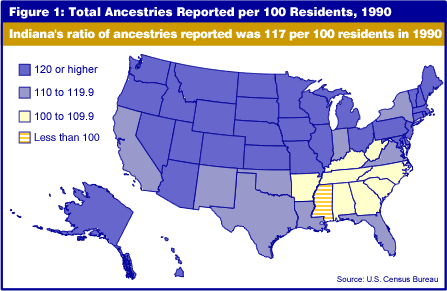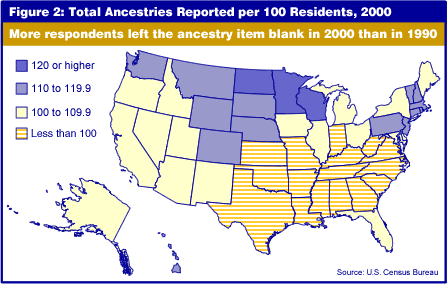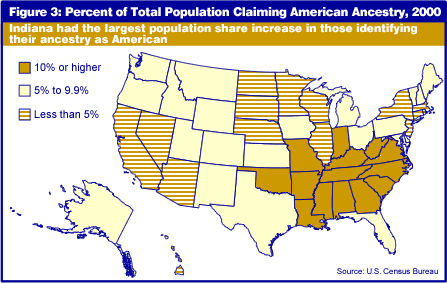Census Ancestry Changes Reflect
Changing America
With the release of new census profiles last month, several media stories made note of the declining number of people in the United States claiming European ancestry. Nationwide, people claiming German ancestry dropped by 15 million, or 26 percent, between 1990 and 2000. Declines totaled 8 million each for both the Irish and English. Numbers were also down for most other European ancestry groups, including Danish, Dutch, French, Scotch-Irish, Swedish and Swiss. Considering that the U.S. population increased by 13 percent over the same period, the large drop in European ancestry represents a big change in the composition of our national population, or at least in the way that we perceive ourselves.
One factor in the drop in population of European descent is "cohort replacement." In effect, the age composition of the country is determining the ancestry composition. Many of the elderly people in the U.S. are of European descent. When they die, they are being replaced by younger cohorts who are either not European or are less likely to identify themselves as belonging to one of the European ancestry groups.
The likelihood of census respondents identifying with any ancestry group is on the decline and certainly accounts for a large portion of the decline in reporting of European ancestries. Compared to 1990, Census 2000 found more respondents leaving the ancestry item blank. The census long form questionnaire allows respondents to list up to two ancestries, so it's possible for the total ancestries reported for any given area to be double that area's population. In the 1990 census, the national ratio of total ancestries reported was 119 per 100 residents. In 2000, that ratio slipped to 102 per 100 residents. The drop in ancestry reporting was even steeper in Indiana, falling to 92 total ancestries per 100 residents in 2000-from 117 in 1990. Presumably, many respondents still select two ancestries, so it's reasonable to conclude that nonresponse is contributing substantially to the falling ratio.
Figures 1 and 2 show the distribution of the 50 states in 1990 and 2000, respectively, on the ratio of total ancestries reported per 100 residents. In 1990, 32 states, primarily in the northern and western regions of the U.S., recorded at least 120 total ancestries per 100 residents. Only Mississippi, at 99.1, had a ratio under 100. By 2000, a combination of item nonresponse along with an apparently growing tendency to report only a single ancestry has radically shifted the map. Only three states now have a total-ancestries-to-total-population ratio of 120 or higher, while the number of states below 100 has grown from one to 16. Ten of those 16 states belonged to the old Confederacy; they are joined by Oklahoma, Kansas, Missouri, Kentucky, West Virginia and Indiana. The Hoosier state stands out in Figure 2 as the northernmost state with fewer than 100 total ancestries reported per 100 residents.


Another significant trend in ancestry reporting behavior is the growing tendency among census respondents to forsake their European heritage in favor of an ancestry response that is coded "United States or American." The number of people claiming American ancestry increased by 58 percent nationwide between 1990 and 2000, a gain of 7.5 million people. In Indiana, this ancestry group grew even faster, with an 85 percent increase over 10 years. It is likely that this trend has had a disproportionate effect on European ancestry groups, since the largest waves of European immigration to the U.S. occurred 80 to 130 years ago. The descendants of these immigrants probably maintain fewer ties to their ancestral homelands and would have a greater tendency to name a single ancestry: American. Figure 3 depicts the share of each state's total population claiming American ancestry in 2000. In fourteen states, mostly southern, at least 10 percent of the total population claimed American ancestry. Again, Indiana is conspicuous as the northernmost state in this category. Indiana, in fact, had the largest increase among all states in the population share identifying their ancestry as American, climbing from 7 percent of all Hoosiers in 1990 to 12 percent in 2000. It's useful to note that these data were collected at least a full year before the September 11th terrorist attacks sparked a resurgence in patriotism. Future tabulations of ancestry for the United States population can be expected to show continued gains in the American ancestry group.

John Besl
Research Demographer,
Indiana Business Research Center,
Kelley School of Business, Indiana University
